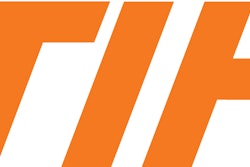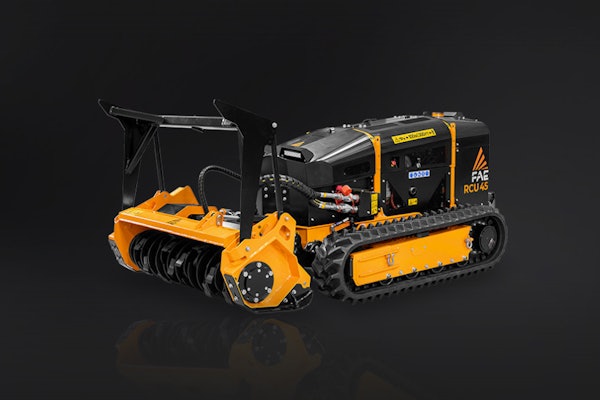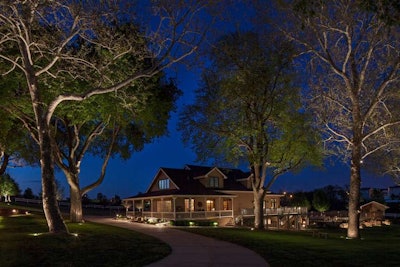 In addition to its aesthetic contribution to design, landscape lighting also enhances security in both residential and commercial settings, as this job by McKay Landscape Lighting illustrates. McKay has offices in Omaha, Nebraska, where the photos here were shot, as well as Des Moines, Iowa.
In addition to its aesthetic contribution to design, landscape lighting also enhances security in both residential and commercial settings, as this job by McKay Landscape Lighting illustrates. McKay has offices in Omaha, Nebraska, where the photos here were shot, as well as Des Moines, Iowa.Photo: McKay Landscape Lighting
EDITOR’S NOTE: Written by Darlene Bremer, this article first appeared in this month’s edition of Electrical Contractor Magazine, the official publication of the National Association of Electrical Contractors (NECA).
While street lighting improves traffic safety by enabling pedestrians and motorists to see each other, it also contributes to aesthetics. Landscape lighting enhances security and accents special features to create a unique atmosphere for outdoor events. As a whole, outdoor lighting is growing faster than the industry average, and yearly growth has been equal to 7.8 percent, according to the market research firm Global Information.
Street and pedestrian lighting trends
The U.S. Department of Energy (DOE) projects that by 2020 more than 75 percent of outdoor luminaire shipments will be light-emitting diodes (LEDs).
“The significant energy and maintenance savings and the ability to more efficiently deliver uniform lighting into useful zones without wasted spill – in combination with costs close to parity with legacy technologies – make the value proposition and ROI for solid-state lighting so compelling that most of our outdoor lighting business has already converted to LED,” said Scott Roos, vice president of product development for Juno Lighting Group by Schneider Electric, Des Plaines, Illinois.
In fact, the change to LEDs for street and pedestrian lighting is more conspicuous than with any other LED application, according to Mark Lien, director of government and industry relations for Osram Sylvania, Danvers, Massachusetts.
“Even though the installed base has not shifted yet, manufacturers are narrowly focused on LED for street lighting applications, and in fact no new HID lamps or luminaires were submitted this year to the 2014 Progress Report published by the Illuminating Engineering Society,” Lien said.
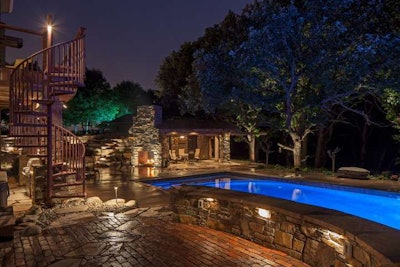 Landscape lighting is a key element of outdoor living areas, enabling clients to make use of their spaces well after the sun goes down. (Click to enlarge.)
Landscape lighting is a key element of outdoor living areas, enabling clients to make use of their spaces well after the sun goes down. (Click to enlarge.)Photo: McKay Landscape Lighting
Although general outdoor lighting is quickly moving to LEDs, it still has some competition, according to Jeff Dross, corporate director, education and industry trends, at Kichler Lighting in Cleveland.
Light-emitting plasma (LEP) technology has proven effective for lighting large, open areas, such as parking lots and shipping yards.
“Currently, the cost per lumen of LEP technology is less than LED, but with the huge amount of investment being made in LEDs, it is possible that this technology will not be able to keep up,” Dross said.
Organic light-emitting diode (OLED) technology is another efficient and effective lighting source. However, with different applications and certain limitations, it does not seem to be an immediate threat to LEDs’ outdoor market share.
“The technology has many significant limitations that, for the foreseeable future, will restrict its outdoor applications to special decorative situations,” Roos said.
Solid-state lighting technology is also redefining outdoor luminaire design, as the light source and associated optics are much different than that of legacy HID fixtures, according to Roos. Lower profile optics and technologically advanced designs (so the housing efficiently dissipates heat from the LEDs) have resulted in thinner profile form factors that can have a more pleasing, less obtrusive daytime appearance.
“The lower profile housings also typically have lower EPA wind ratings that allow the use of thinner, more attractive, less costly poles,” he said.
Because solid-state lighting is more practical to dim than legacy sources, fixtures are more frequently being programmed to reduce light levels during off-peak hours or to respond to motion detection.
As the costs associated with luminaires continue to decline, the installation portion of projects is becoming a higher percentage, according to Eric Gibson, director of commercial outdoor product solutions for Acuity Brands, Atlanta.
“Therefore, the industry is focusing on finding ways to reduce installation costs, such as universal mounting brackets, minimizing or eliminating drilling on poles, and more efficient fastening methods,” he said.
While controls used to be considered just an add-on to outdoor lighting, energy savings and legislation, the International Dark-Sky Association and other light-pollution initiatives are driving controls to become an integral part of any lighting project.
Landscape lighting trends
Landscape lighting is traveling on a slightly different path than pedestrian and street lighting.
“Low-voltage landscape lighting, used primarily in residential and light commercial applications, has almost completely transitioned to LED technology,” Dross said.
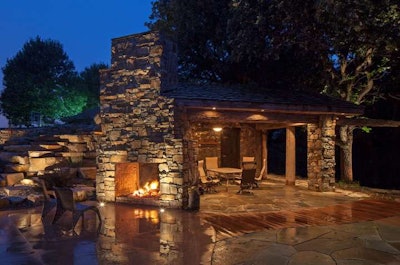 The use of outdoor lighting to enhance landscape designs is increasing.
The use of outdoor lighting to enhance landscape designs is increasing.Photo: McKay Landscape Lighting
While LEDs have certainly provided energy savings for the customer, electrical contractors quickly learned they could share in the benefits as well.
“The elimination of voltage drop made the installation simpler, reduced the size of the transformer and often precluded the need for larger gauge wire,” Dross said.
As more attention becomes focused on the aesthetics in landscape lighting applications, lighting and control systems are playing a more important role, according to David Brooks, technical solutions manager, Traxon Technologies, an Osram business.
“Enhancing outdoor spaces with lighting is becoming increasingly popular, and the use of color-changing lighting for landscapes, public exterior spaces and bridges is becoming more commonplace,” he said.
According to Gibson, landscape lighting is moving beyond traditional RGB and offering nuances of tunable light, providing more flexibility in setting outdoor scenes.
“LED products offer better architectural integrations and concealment, offer less maintenance due to their longer rated life and can, with controls, add seasonal color effects and timer capabilities,” Lien said.
However, projects do not need to have large, complex systems to enhance the lighting’s look and feel. Something as simple as adding a few well-placed luminaires can greatly enhance outdoor spaces and experiences.
As more energy regulations are adopted, it will be harder to justify the use of halogen or incandescent lamps for landscape lighting applications. Current LED solutions – with their high energy efficiency, low lifecycle maintenance costs, optical performance and intelligent control integration – will take over.
Becoming fully integrated and intelligent
While there is a lot of talk about intelligent outdoor lighting systems, most of these installations seem to be centered on municipal street lighting projects or large campuses with vast arrays of outdoor lighting fixtures that, along with other dispersed capital assets, would be exceptionally difficult to maintain without remote monitoring and control over the Internet.
“Key challenges to (more widespread) adoption of intelligent outdoor lighting systems include standardizing controls and communications protocols, resolving concerns over cybersecurity and complex design, and commissioning and managing a network of intelligent fixtures,” Roos said.
While some intelligent lighting systems are working well and integrating effectively, others are not.
“We are currently at the birth of intelligent lighting systems,” Dross said. “Contractors will need to experiment with the assorted available options.”
As the technology evolves, it will eventually settle on a universal system, and it will change again once something better comes along.
Regardless of the current state of intelligent, integrated outdoor lighting, Gibson said it is the direction the industry is going.
“Customers – driven by the need for energy savings or by legislation compliance, aesthetic needs or green building initiatives – are demanding that they get the right amount of lighting when and where it’s needed,” he said.
As for landscape lighting, that sector is playing catchup in terms of fully integrated systems.
“Unlike many LED area and site lighting luminaires, which can accommodate a wide variety of integral sensor and wireless controls solutions, the sensors and components have not yet reached the smaller size required for landscape lighting,” said Zachary Ingalls, product manager for Eaton Corp., Cleveland.
The outside future
As the industry continues to move toward solid-state lighting in pedestrian, street and landscape applications, systems will become fully integrated to the point that the user doesn’t even recognize that the controls are there.
According to Dross, the future for outdoor and landscape lighting is promising.
“This is a wildly changing environment,” he said. “Homeowners are realizing that residential landscape lighting can increase the usage of their home well into the night. Properly lighted commercial buildings are becoming more inviting because of their perceived safety. And municipalities and building owners are finally realizing the benefits of more efficient lighting.”
Assuming the efficacy of LED luminaires increases an additional 50 percent over current levels by 2020, as DOE predicts, general outdoor lighting fixtures will be designed with even smaller and sleeker footprints. Fewer LEDs will deliver the same amount of light with less heat, according to Roos.
In addition, increased lumen density of LED packages will concentrate more lumens into smaller light-emitting surfaces, which will further improve the level of optical control that can be achieved using LEDs.
“Improved optical control will increase LEDs’ ability to provide exceptionally uniform, precisely directed light with even fewer wasted lumens that create light pollution, glare and light trespass,” he said.
Roos foresees that all of these elements combined will result in municipal standards for minimum light levels to be dropped, which will drive energy costs to unprecedented low levels.
“And if that isn’t enough, as outdoor lighting fixtures become part of the Internet of Things, they will be able to be programmed to vary the light level based on projected activity, events and weather conditions to further reduce our outdoor-lighting-energy footprint,” he said.
All of this change may require electrical contractors – not to mention landscape designers – to learn new things and perform new tasks. However, those contractors can provide aesthetic solutions, energy-efficiency benefits and safety statistics that will win in the future.

